

Cellmedicine: ses vidéos. Italian doctor may have found surprisingly simple cure for Multiple Sclerosis. An Italian doctor has been getting dramatic results with a new type of treatment for Multiple Sclerosis, or MS, which affects up to 2.5 million people worldwide.

In an initial study, Dr. Paolo Zamboni took 65 patients with relapsing-remitting MS, performed a simple operation to unblock restricted bloodflow out of the brain - and two years after the surgery, 73% of the patients had no symptoms. Dr. Zamboni's thinking could turn the current understanding of MS on its head, and offer many sufferers a complete cure. Multiple sclerosis, or MS, has long been regarded as a life sentence of debilitating nerve degeneration. It's generally accepted that there's no cure for MS, only treatments that mitigate the symptoms - but a new way of looking at the disease has opened the door to a simple treatment that is causing radical improvements in a small sample of sufferers.
Italian Dr. Dr. He immediately took to the ultrasound machine to see if the idea had any merit - and made a staggering discovery. National Multiple Sclerosis Society - Wiki. The National Multiple Sclerosis Society, a United States-based non-profit organization, and its network of chapters nationwide help people affected by MS by funding research, driving change through advocacy, facilitating professional education, and providing programs and services that help people with multiple sclerosis and their families.
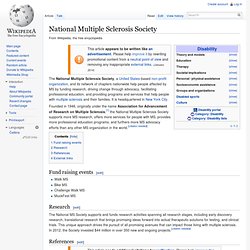
It is headquartered in New York City. Founded in 1946, originally under the name Association for Advancement of Research on Multiple Sclerosis,[1] the National Multiple Sclerosis Society supports more MS research, offers more services for people with MS, provides more professional education programs, and furthers more MS advocacy efforts than any other MS organization in the world. [citation needed] Fund raising events[edit] Multiple sclerosis - Wiki. Multiple sclerosis (MS), also known as disseminated sclerosis or encephalomyelitis disseminata, is an inflammatory disease in which the insulating covers of nerve cells in the brain and spinal cord are damaged.
This damage disrupts the ability of parts of the nervous system to communicate, resulting in a wide range of signs and symptoms,[1][2] including physical, mental,[2] and sometimes psychiatric problems.[3] MS takes several forms, with new symptoms either occurring in isolated attacks (relapsing forms) or building up over time (progressive forms).[4] Between attacks, symptoms may go away completely; however, permanent neurological problems often occur, especially as the disease advances.[4]
Biogen Idec UK - Test Drugs For The FDA. Elan Is Responsible For Testing For TheFDA. Alemtuzumab - Wiki. Alemtuzumab is a drug used in the treatment of chronic lymphocytic leukemia (CLL), cutaneous T-cell lymphoma (CTCL) and T-cell lymphoma under the trade names Campath, MabCampath and Campath-1H, and in the treatment of multiple sclerosis as Lemtrada.

It is also used in some conditioning regimens for bone marrow transplantation, kidney transplantation and islet cell transplantation. It is a monoclonal antibody that binds to CD52, a protein present on the surface of mature lymphocytes, but not on the stem cells from which these lymphocytes are derived. After treatment with alemtuzumab, these CD52-bearing lymphocytes are targeted for destruction. Alemtuzumab is used as second-line therapy for CLL. It was approved by the US Food and Drug Administration for CLL patients who have been treated with alkylating agents and who have failed fludarabine therapy. Medical uses[edit] Oligoclonal band - Wiki. Oligoclonal bands are bands of immunoglobulins that are seen when a patient's blood serum, gained from blood plasma, or cerebrospinal fluid (CSF) is analyzed.

Two methods of analysis are possible: (a) protein electrophoresis, a method of analyzing the composition of fluids, also known as "agarose gel electrophoresis/Coomassie Blue staining", and (b) the combination of isoelectric focusing/silver staining. The latter is more sensitive.[1] For the analysis of cerebrospinal fluid, a patient has a lumbar puncture performed, which collects some of his or her cerebrospinal fluid. Each of the two to five oligoclonal bands seen by protein electrophoresis represent proteins (or protein fragments) secreted by plasma cells, although why exactly these bands are present, and which proteins these bands represent, has not yet been elucidated.
Uric acid - Wiki. Uric acid is a heterocyclic compound of carbon, nitrogen, oxygen, and hydrogen with the formula C5H4N4O3.
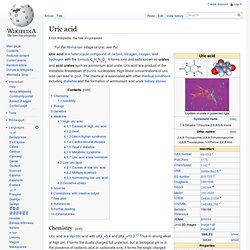
It forms ions and salts known as urates and acid urates such as ammonium acid urate. Uric acid is a product of the metabolic breakdown of purine nucleotides. High blood concentrations of uric acid can lead to gout. The chemical is associated with other medical conditions including diabetes and the formation of ammonium acid urate kidney stones. Chemistry[edit] Uric acid is a diprotic acid with pKa1=5.4 and pKa2=10.3.[1] Thus in strong alkali at high pH, it forms the dually charged full urate ion, but at biological pH or in the presence of carbonic acid or carbonate ions, it forms the singly charged hydrogen or acid urate ion as its pKa1 is lower than the pKa1 of carbonic acid. As a bicyclic, heterocyclic purine derivative, uric acid does not protonate at an oxygen [-OH] like carboxylic acids do.
Addressin - Wiki. Addressin also known as mucosal vascular addressin cell adhesion molecule 1 (MAdCAM-1) is a protein that in humans is encoded by the MADCAM1 gene.[2][3][4] Addressin is an extracellular protein of the endothelium of venules.
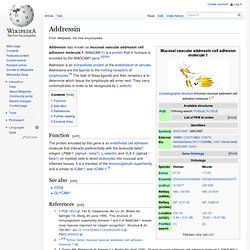
Addressins are the ligands to the homing receptors of lymphocytes.[5] The task of these ligands and their receptors is to determine which tissue the lymphocyte will enter next. HLA-DR15 - Wiki. HLA-DR15 (DR15) is a HLA-DR serotype that recognizes the DRB1*1501 to *1505 and *1507 gene products.

DR15 is found at high levels from Ireland to Central Asia. DR15 is part of the older HLA-DR2 serotype group which also contains the similar HLA-DR16 antigens. Serology[edit] Serotypes are unknown the following alleles: DRB1*1506, *1508 to *1516, *1518 to *1522. HLA-DQ6 - Wiki. HLA-DQ6 (DQ6) is a human leukocyte antigen serotype within HLA-DQ (DQ) serotype group.
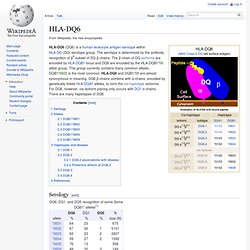
The serotype is determined by the antibody recognition of β6 subset of DQ β-chains. The β-chain of DQ isoforms are encoded by HLA-DQB1 locus and DQ6 are encoded by the HLA-DQB1*06 allele group. This group currently contains many common alleles, DQB1*0602 is the most common. Osteopontin - Wiki. Not to be confused with Osteocalcin, Osteonectin or Osteoprotegerin (OPG).
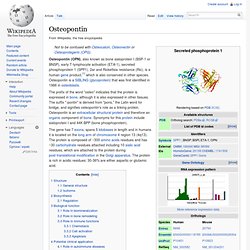
Osteopontin (OPN), also known as bone sialoprotein I (BSP-1 or BNSP), early T-lymphocyte activation (ETA-1), secreted phosphoprotein 1 (SPP1), 2ar and Rickettsia resistance (Ric), is a human gene product,[1] which is also conserved in other species. Osteopontin is a SIBLING (glycoprotein) that was first identified in 1986 in osteoblasts.
The prefix of the word "osteo" indicates that the protein is expressed in bone, although it is also expressed in other tissues. The suffix "-pontin" is derived from "pons," the Latin word for bridge, and signifies osteopontin's role as a linking protein. Natalizumab - Wiki. Natalizumab is a humanized monoclonal antibody against the cell adhesion molecule α4-integrin.
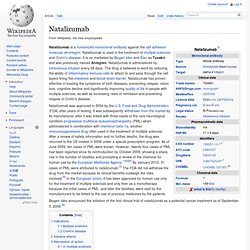
Natalizumab is used in the treatment of multiple sclerosis and Crohn's disease. It is co-marketed by Biogen Idec and Élan as Tysabri, and was previously named Antegren. Natalizumab is administered by intravenous infusion every 28 days. The drug is believed to work by reducing the ability of inflammatory immune cells to attach to and pass through the cell layers lining the intestines and blood–brain barrier. Natalizumab has proven effective in treating the symptoms of both diseases, preventing relapse, vision loss, cognitive decline and significantly improving quality of life in people with multiple sclerosis, as well as increasing rates of remission and preventing relapse in Crohn's disease.